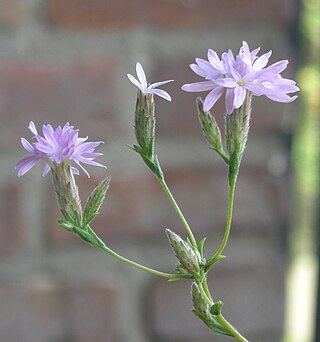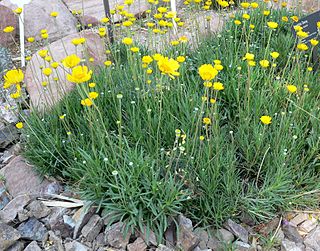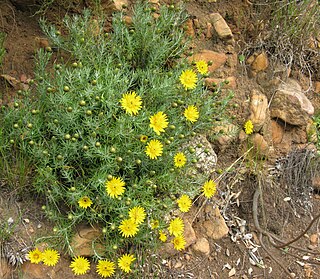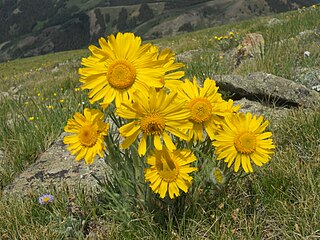
Hymenoxys is a genus of plants in the sunflower family, native to North and South America. It was named by Alexandre Henri Gabriel de Cassini in 1828.

Lessingia is a genus of plants in the family Asteraceae which are native to western North America. Several species are endemic to California.

Amblyopappus is a genus of flowering plants in the family Asteraceae described as a genus in 1841.

Hymenoxys odorata is a species of flowering plant in the daisy family known by the common names bitter rubberweed and western bitterweed. It is native to the southwestern and south-central United States from southern California to Texas north as far as Kansas and Colorado, as well as northern Mexico. It grows in dry regions.

Calochortus uniflorus is a species of flowering plant in the lily family known by the common names Monterey mariposa lily and large-flowered star-tulip. It is native to western Oregon and to California as far south as San Luis Obispo County. It grows in moist areas, such as meadows, in coastal hills and lower-elevation mountains. Most of the populations are found in the Coast Ranges, but some occur in the Cascades and in the foothills of the Sierra Nevada.

Senna gaudichaudii, also known by many common names, including kolomana in Hawaii and as blunt-leaved senna in Australia, is a species of flowering plant in the family Fabaceae and is native to some Pacific Islands including Hawaii, parts of Southeast Asia and Queensland in Australia. It is shrub or small tree with pinnate leaves, usually with three to five pairs of oblong to egg-shaped leaflets, and yellow flowers arranged in groups of four to ten, with ten fertile stamens in each flower.

Tetraneuris, commonly known as four-nerve daisy or bitterweed, is a genus of North American plants in the sneezeweed tribe within the daisy family.

Heterolepis is a genus of flowering plants in the sunflower family. It has three or four species, all endemic to the Western Cape Province in South Africa.

Plectocephalus is a genus of plants in the tribe Cardueae within the family Asteraceae.

Chaetymenia is a genus of flowering plants in the daisy family.

Tetraneuris acaulis is a North American species of flowering plants in the sunflower family. Common names include angelita daisy, stemless four-nerve daisy, stemless hymenoxys, butte marigold, and stemless rubberweed.
Leptostelma is a genus of South American flowering plants in the family Asteraceae.
Hymenoxys ambigens is a species of flowering plant in the daisy family known by the common name Pinaleño Mountains rubberweed. It is native to the states of Arizona and New Mexico in the southwestern United States.
Hymenoxys brandegeei is a species of flowering plant in the daisy family known by the common names Brandegee's four-nerve daisy, Brandegee's rubberweed or western bitterweed. It is native to the states of Arizona, Colorado, and New Mexico in the southwestern United States.

Hymenoxys grandiflora is a North American species of flowering plant in the daisy family known by the common names graylocks four-nerve daisy, graylocks rubberweed, or old man of the mountain. It is native to high elevations in the Rocky Mountains of the western United States.
Hymenoxys robusta is a South American species of flowering plant in the daisy family. It has been found primarily in Bolivia with a few populations in nearby Peru and Argentina.
Hymenoxys cabrerae is a South American species of flowering plant in the daisy family. It has only been found in Argentina
Tetraneuris linearifolia is a North American species of plants in the sunflower family, known by the common name fineleaf fournerved daisy. It grows in the south-central United States and northern Mexico.
Tetraneuris turneri is a North American species of plants in the sunflower family, known by the common name Turner's four-nerve daisy. It has been found in the US state of Texas and in the nearby Mexican state of Coahuila.
Velva Elaine Rudd was an American botanist, specializing in tropical legumes. She worked as a curator at the Smithsonian Institution's National Museum of Natural History and also conducted research at the herbarium at California State University, Northridge.











